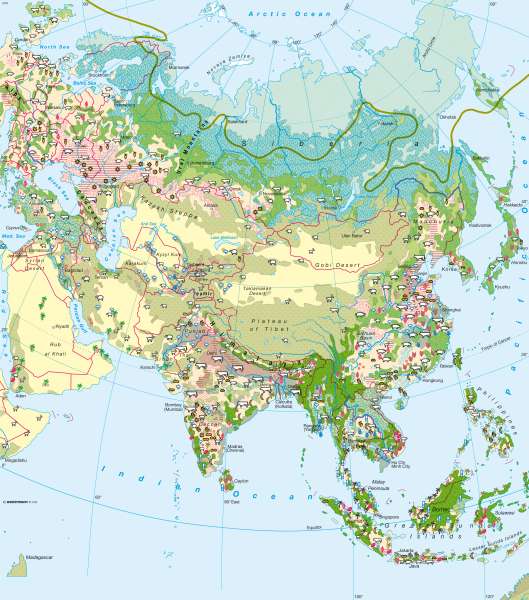Agriculture
Asia - Agriculture and climate
978-3-14-100790-9 | Page 94 | Ill. 1

Information
Asia's natural environment is not only the largest, but may even be the most diverse continent on Earth.All vegetation zones of the Earth are represented in Asia both horizontally and vertically. Its north-south extension extends from the equator to the North Pole. Ultimately, the agricultural diversity of Asia is based on these gigantic proportions.Vegetation and land use
Agriculture is strongly influenced by the natural features of a landscape. Therefore different types of land use predominate the different vegetation zones in Asia. The map shows the links between agriculture, climate and relief. The highlands of Tibet, for example , is a cold desert and has unfavourable agricultural potential high position and the surrounding mountain ranges the Himalayas and Kunlun Shan.
Large parts of Central Asia, the Middle East and the Arabian Peninsula are characterised by oases and irrigated crops of cotton and date palm . The river oases on such rivers as the Indus like the Indus, the Euphrates, Amu Darya and Syr Darya are particularly striking.
The drier parts of Asia were shaped over long stretches through extensive livestock farming, where a widespread nomadism originally existed .Today, this form of agriculture has declined in all states due to social, political and economic reasons.
The dominant industry in northern Siberia is logging. Temperature and precipitation conditions from Western Siberia to Kazakhstan allow for a laminar grain cultivation in the east, which due to its form, also disperses insularly. The livestock sector plays a major role only in Kazakhstan.
Large parts of eastern China can be treated as a model for areas of Asia with intensive agricultural use. In the northern parts of the country, the Great Plain and Manchuria, wheat and maize are the main crops and peanuts are the most important oil source. Rice is the dominant crop in the south, followed by sugar cane, tea, peanuts, and vegetables. In the livestock industry in the south, the role of the indespensible water buffalo is significant in rice cultivation. Other than that, Pigs are the dominant livestock in China.
The Indian subcontinent is in many forms similar to China. The crop production is in close connection with the seasonal March rainfall. A conditional hygric east-west conflict is displayed along the Himalayas; the total precipitation in the east continues to the west, therefore in the east mainly rice is grown and in the west usually wheat. Due to the seasonal distribution of rain, irrigated crops are widespread. Millet dominates as a staple in the drier southern India; this is favoured merely due to rainfall on the coasts - especially in the West — where rice cultivation is also possible. Coconut and peanuts are the main sources of fat.
In Bangladesh, one of the poorest developing countries in the world, the cultivation of jute has special meaning: The country is the world's top exporter of jute. Jute is a three to four metres high reed-like plant and has been cultivated since the end of the 19th Century. Approximately one third of the population is dependent on the jute economy. One of the biggest obstacles for agriculture are the many floods which occur.
Environmental hazards
Southeast Asia is characterised by a dramatically decreasing proportion of tropical rain forests. For decades, wood has served as an important export item. Today, the last soft-wood forests have had to make way for the sprawling plantations of palm oil crops planted for biofuels. The problems of the use or overuse of the last remaining rain forests by humans are similar in this region, as in the Amazon region.
A second major environmental problem today is the rising ground water caused by soil salinity in irrigated areas, which affects about 30 percent of the land. This phenomenon is particularly apparent at the lower Indus River and the region around the Aral Sea (once the fourth largest lake in the world). The rigorous removal of water on an ecologically dead dwarf lake has resulted in a desert landscape due to salt and dust storms. A third and massive environmental problem is the continuing desertification of large areas of the already acutely affected Central Asia and Persian Gulf through blowing, aggradation and thinning.
H. Schulze; Ü: C. Fleming




